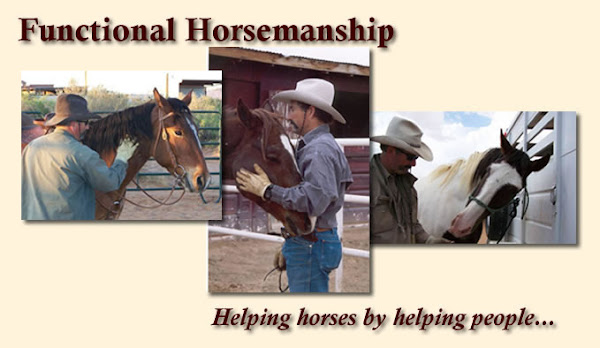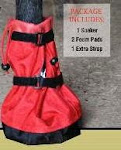While I had, seen or helped with many horses colicing, horse wrecks, injured horses, a case or two of founder, a horse stricken wth West Nile and even a case of strangles, I had never experienced a horse health issue like this, where we could not pin point the cause, so I wanted to share with the Functional Horsemanship readers.
Day One. On Wednesday early morning I noticed one of my geldings, Junior, eating, but not with his normal gusto. I ask my wife to keep an eye on him through the day.
Around noon, Junior still appeared off and hadn't finished his morning feed. We called our Vet, Amy Starr, DVM owner/operator of
Paws'n Hooves Mobile Veterinary Clinic. She arrived about 4 pm. Her exam revealed normal gut sounds, normal heart rate and normal temperature. The Vet palipated Junior, no gut tension or inflammation noted. Doc Starr tubed Junior giving water, epson salts and mineral oil into gut. Water for hydration, mineral oil to help lubricate the gut in case of an impaction, and epson salts to help draw body fluids into the gut.
Right after Vet left, horse passed a normal looking pile. And because of this and Junior's gut sounds and physical exam we did not think the problem was colic. My Vet also several vials of bloob for lab analysis.
I watched Junior throughout the night. He still was not eating and did not appear to be drinking.
Day Two.. Thursday morning, Junior still not interested in feed. He had good gut sounds, but still had not passed anymore manure. Vet called me to check on Junior and to give me the blood work results. The blood analysis came back as his organ functioning well but the CBC blood count was down just a little indicating maybe a small virus or a little stress.
The Vet came out again Thursday evening, during a snow storm I might add. My horse had not passed the oil that the Vet gave him over 24 hours earlier. She palipated my horse again, and he appeared normal. Normal gut sounds and normal temperature, but dehydrated. The Vet gave horse a water and detergent enema. Apparently the detergent (Tide) helps break up any impaction. At this time we still did not feel this was a colic but the horse was not drinking water (nor eating) so we were concerned that this could turn into a colic case or have colic a secondary issue.
Within an hour the horse shot (like a water cannon) the enema mix back out his rectum. The Vet gave Junior 10 litres of fluids IV. It was a very cold night, into the low 20's, so the Vet could not tube Junior again,.....the cold made the tube pretty unflexible and she just could get it into his stomach to adminster more fluids and mineral oil. Even soaking the tube in hot water did not help as once removed from the hot water the tube would get instantly stiff. At this point we thought dehydration was the biggest threat.
We had moved the horse into a broodmare stall and put a 17 quart bucket of warm, so I could monitor his drinking. I also gave him a handful of hay to eat since he had not eaten anything in at least 36 hours. I checked on him ever two hours throughout the night.
Day Three. On Friday morning the horse was still not eating much at all. He would eat a handful of alfalfa but then stop. He did not appear to be drinking either.
Friday mid afternoon, I decided to trailer Junior to the Vet's place so he could be in a hospital stall and be given more fluids and monitored more often.
But once in the trailer Junior passed a pile with mineral oil, this was 47 hours after being tubed with mineral oil (on Wednesday). He appeared to be much better, so we took him out of the trailer and offered some feed. He began to eat a little, so we decided to postpone trailering him to the Vet's. I put him back into the broodmare stall to monitor feed and water.
But then he stopped eating and did not drink so we loaded him back up into the trailer and took to the Vet's around 7 pm.
So Friday evening found us at the Vet's facility (San Francisco Stables) where he was given 10 litres of fluids IV again, and we got him to eat about 1/8th flake of alfafa and about 1/2 pound of fortified feed (Patriot). We left him late that night in the very capable hands of Doc Starr and her husband Panchito.
Day Four. Saturday morning Junior ate a light flake of alfalfa and was given an additional 10 litres of fluid via IV throughout the day. He also drank around a gallon water throughout the day as well.
In the evening he ate another light flake of afalfa, and was given 30 grams of Pro-Bios probiotic paste as well.
Day Five. On Sunday morning Junior was given a light flake of aflafa and a little grass. He ate that, drank about a gallon of water and was turned out for a couple hours.
Sunday afternoon, Junior ate alittle more afalfa and grass, and drank about a gallon of water. So we made plans on picking him up that evening.
Sunday early evening we arrived at my Vet's. Junior had received and ate an additional 6 lbs or so of afalfa-grass mix just before we arrived. We trailered him home where around midnight we gave him another 4 lbs of grass and a full bucket of water to monitor his water intake.
Day Six. Monday morning. I checked Junior at morning feeding time. He had ate all the hay I had given him the night before and had drank the whole 17 quart bucket of water through the night. I gave him 15 grams of Pro-Bios, re-filled his water and gave him 6 to 7 lbs of afalfa-grass mix and we left him stalled by himself to monitor.
In the early afternoon, Junior was hungry again and needed more water. Plus he had a regular amount of normal looking manure.
Days later he is still doing good. In fact, while through this sickness, virus or whatever it was, he appeared mostly normal. Ears forward, tracking movement with his head and eyes. No normal colic signs like standing extended, biting at his sides, ears back, or trying to lay down. Really the only indication was the lack of interest in feed and not drinking and that dullish look in his eyes that he was offl - most of you know what I mean.
We are thinking that this was some sort of virus, not colic. None of our other horses have exhibited anything like it yet. It was probably fortunate that Junior was the affected horse since he is very well conditioned and muscled. This would have taken much more out of a lesser or older horse.
My wife and I have had some damn good vets over the years. But Doc Starr is the first Vet we have had who does not hestiate to give enemas or use IV fluids. Receiving fluids IV when not otherwise drinking can be vital in giving a horse a chance - I believe it was in Junior's case.




















